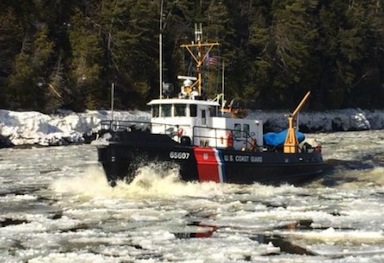The following is the text of a news release from the U.S. Coast Guard:
(BOSTON) — With local temperatures edging toward single digits, and reports of initial ice forming throughout New England, the Coast Guard's winter icebreaking season has kicked off in the Northeast.
The season officially started Dec. 15 and runs through March. During the Coast Guard’s 2015-2016 winter icebreaking season, known as Operation Reliable Energy for Northeast Winters (RENEW), the Coast Guard will conduct icebreaking operations for several reasons:
• To facilitate security operations with ports, waterways and coastal security missions;
• To help prevent loss of life on the water and ashore when impacted by ice;
• To provide urgent response to vessels that are directly impacted by ice;
• To support communities that have need for fuel, food and medical supplies;
• To assist in preventing or easing flood conditions;
• To meet the reasonable demands of commerce to facilitate navigation on frozen, navigable waterways.
Operation RENEW is the Coast Guard's regionwide effort to ensure Northeast communities have the security, supplies, energy, and emergency resources they need throughout the winter. Coast Guard units throughout the Northeast have been busy preparing for Operation RENEW by conducting training operations and prioritizing efforts. They are also replacing aids to navigation with special aids designed to ride underneath ice floes and remain on location. And the impact of these efforts extends well beyond the Northeast region.
More than 80 percent of the nation’s home heating oil needs are in the northeastern U.S., and 90 percent of that fuel will be delivered, at some point, by barge through Coast Guard Northeast waters.
An average of 300 vessels transit the Hudson River during the winter months, carrying over 10 million barrels of petroleum products to the Northeast communities.
To conduct Operation RENEW, Coast Guard crews will use:
• 140-foot seagoing icebreaking tugs;
• 65-foot small harbor tugs;
• 225-foot Juniper-class buoy tenders;
• 175-foot Keeper-class buoy tenders;
• 49-foot buoy utility stern loading (BUSL) boat;
• U.S. Coast Guard aircraft;
• U.S. Coast Guard auxiliary aircraft.
In 2014, the Coast Guard facilitated the movement of an estimated 7.96 million barrels of petroleum products and an estimated 297,000 tons of dry bulk products in the Northeast, which totaled near $2 billion.
The 2014-2015 season was moderate to severe in terms of ice coverage and duration, and the harshest ice season since 2004. Ice began forming in mid-December on the Hudson, Kennebec and Penobscot rivers, continued building throughout the winter with only a few short warm trends, and lasted through early April. Ice thicknesses varied from 4 to 30-plus inches throughout 1st District and required major icebreaking efforts in all fresh/brackish waterways to keep them open for commercial passenger and petroleum cargo transits. The extreme cold created saltwater ice in many waterways which had not experienced ice in a decade.
Coast Guard missions and capabilities are established to support investment security, innovation, and resilience, which are the foundations of a growing economy. The Coast Guard provides a safe, efficient, and navigable waterway system that supports domestic commerce, international trade and national defense.

